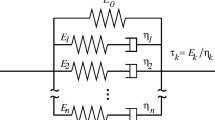Abstract
It is well known that the relaxation modulus of a linear-isotropic-viscoelastic material under uniaxial load is the stress history of a unit-step strain history. A unit-stepped strain function cannot be obtained with the common instron testing machine. Instead, an easily obtainable strain function is described from which the relaxation modulus is derived. Experiments were conducted to illustrate this method. Experimental-data-reduction techniques are described. Experimentally measured output stress vs. time is fitted by a ‘smooth’ polynomial using a least-square criterion. Then by differentiation of this polynomial at proper times, the relaxation function is obtained.
Similar content being viewed by others
Abbreviations
- t, τ1 :
-
time (s)
- σ(t):
-
stress (Pa, 1 MPa=145 psi)
- ∈(t):
-
strain (mm/mm)
- E(t) :
-
relaxation modulus (Pa)
- h(t) :
-
step function
- δ(t):
-
dirac-delta function
- ɛ o :
-
strain (mm/mm)
- G ijkl :
-
generalized relaxation modulus (Pa)
- α:
-
strain rate (1/s)
References
Gross, B. Mathematical Structure of the Theories of Viscoelasticity, Hermann, Paris (1953).
Bland, D.R., The Theory of Linear Viscoelasticity, Pergamon Press, Oxford (1960).
Gottenberg, W.G. andChristensen, R.M., “An Experiment for Determination of the Mechanical Properties in Shear for a Linear, Isotropic Viscoelastic Solid,”Int. J. Engrg. Sci.,2,45 (1964).
Christensen, R.M., Theory of Viscoelasticity, An Introduction, Academic Press, New York and London (1971).
Gurtin, M.E. andSternberg, E., “On the Linear Theory of Viscoelasticity,”Archive for Rational Mechanics and Analysis,11 (4),291 (1962).
Gottenberg, W.G., “Personal Communications”.
Willers, F.A., Practical Analysis, Dover Pub., New York (1948).
Dauer, F.W., “Experimental Methods and Solid State Devices,” EM 109b Term Report, Yale University (1962).
Author information
Authors and Affiliations
Rights and permissions
About this article
Cite this article
Bhushan, B., Dauer, F.W. Experimental determination of the relaxation modulus of a linear-isotropic-viscoelastic material. Experimental Mechanics 18, 421–425 (1978). https://doi.org/10.1007/BF02325058
Issue Date:
DOI: https://doi.org/10.1007/BF02325058



